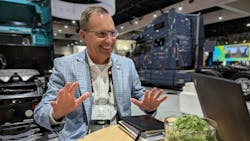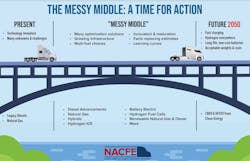NACFE Run on Less sets sights on trucking’s ‘messy middle’
Things are about to get efficiently messy in trucking.
The North American Council for Freight Efficiency is planning its fifth Run on Less event, which will focus on the NACFE-coined phase of trucking’s powertrain transformation: the Messy Middle.
The 2025 run will study trucking’s long-haul segment, including trucks that return to base and those in over-the-road duty cycles. According to Mike Roeth, NACFE’s executive director, it will feature fleets deploying Class 8 day cab and sleeper trucks with various alternative fuel powertrains and the best energy efficiency technologies.
“We all know that there are a lot of solutions for decarbonizing longer-haul freight, and NACFE is going to take that head-on,” Roeth told FleetOwner this week. “We feel it’s our responsibility to help the industry figure out what’s available now, then soon, and into the future.”
Run on Less—Messy Middle aims to explain various decarbonization efforts, including alternative fueling options, and explore the impact of the duty cycle on powertrain selection. The research group is still looking for sponsors, fleet participants, and other contributors to join the line of Run on Less studies dating back to 2017’s inaugural Run.
See also: What NACFE learned from Run on Less—Electric Depot
More about Run on Less—Messy Middle
The three-week demonstration will showcase real-world solutions for fleets operating heavy-duty Class 8 trucks in medium- to long-haul return-to-base and over-the-road duty cycles. It includes freight movement demonstrations to determine what early-adopting fleets can accomplish with alternative powertrains.
NACFE provided these details on the 2025 study:
What to expect
- All trucks will be Class 8 heavy-duty tractors.
- Multiple technologies will be featured, including fast-charging battery electric trucks, hydrogen fuel cell trucks, trucks operating on renewable fuels, and other vehicle efficiency features.
- There will be a focus on long return-to-base operations and long-haul over-the-road using day cabs and sleepers.
- Data will be collected and shared via a website dashboard for each vehicle in the Run.
Run on Less—Messy Middle will…
- Explain the various alternative fueling options across various infrastructure strategies.
- Explore the impact of duty cycle on powertrain selection.
- Look into needed infrastructure changes to accommodate alternative-fueled vehicles.
- Engage experts throughout the industry in the conversations, such as Bootcamp, industry events, thought leadership, etc.
- Facilitate conversations around the necessary actions required.
NACFE will publish a report detailing the findings of the Run in the middle of 2026.
Features of the Messy Middle Run
NACFE and RMI believe fleets face an array of powertrain options for Class 8 trucks, and the benefits and challenges of each option may not be readily apparent.
Run on Less—Messy Middle will feature around 10 fleets deploying trucks with differing decarbonization technologies. As in previous Run on Less demonstrations, the technology will either be commercially available or representative of the manufacturer’s plans.
What makes decarbonizing long haul so messy?
The first Run on Less focused on finding the most efficient long-haul operations with conventional diesel equipment. In 2019, NACFE studied the efficiency of regional operations. The third Run on Less in 2021 turned to various electric truck and van fleet operations. The most recent Run on Less focused on fleet depots running multiple EVs ranging from Class 2 to Class 8 operations.
This Messy Run will focus on long-haul trucking (including medium-haul operations that return to base). While that segment includes just 9% of U.S. trucks on the road, it generates 48% of vehicle emissions, according to the National Renewable Energy Laboratory.
Roeth concedes this Run on Less will be tricky since some of the alternative powertrain technologies are “not all ready for prime time. So having them all in the Run is tricky. But we’re going to try to figure that out over the next six months as we go into the spring and set up our Bootcamps and visit all the sites that will be part of the Run in September 2025.”
But that is just part of the messiness of this segment. With stricter emissions standards being enforced on manufacturers this decade, more fleets face uncertainty when deciding what new transportation technologies to adopt. And there continues to be a lot of skepticism about abandoning the internal combustion engine for long-haul freight.
NACFE’s past Runs have demonstrated how EVs can work in regional operations with return-to-base routing and urban operations. For long haul, there are multiple potential solutions, such as internal combustion engines running on natural gas, renewable diesel, or hydrogen; or battery electric and hydrogen fuel cells.
“It is messy because there is not one solution that is right for every fleet or even for every duty cycle within a fleet,” Roeth wrote in a Messy Middle explainer for FleetOwner in 2022. "It is messy having to have a multi-pronged approach. It is far cleaner to choose one power source and stick with it, but it is not more efficient to do that. Nor is it responsible to just opt out of the whole process of reducing the trucking industry’s carbon footprint.”
See also: Demonstration proves fleet electrification is possible—but there’s still a way to go
How to get involved in Run on Less
The Run on Less—Messy Middle begins in September 2025. NACFE is already planning its popular virtual Bootcamp series, which offers fleets a deeper look at various technologies. The NACFE staff will also spend much time visiting participating fleets to learn more about their operations through discussions with managers and drivers.
The Run’s results, including reports, documents, and videos, will be published at RunOnLess.com. NACFE is seeking fleets and OEMs to participate in its fifth Run and sponsors to underwrite costs. Contact information is available on its website.
“I am excited that we are going to highlight a variety of ways for fleets to lower emissions in the very challenging long-haul segment of the trucking market,” Roeth said.
About the Author
Josh Fisher
Editor-in-Chief
Editor-in-Chief Josh Fisher has been with FleetOwner since 2017. He covers everything from modern fleet management to operational efficiency, artificial intelligence, autonomous trucking, alternative fuels and powertrains, regulations, and emerging transportation technology. Based in Maryland, he writes the Lane Shift Ahead column about the changing North American transportation landscape.


